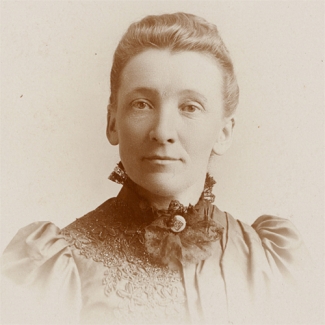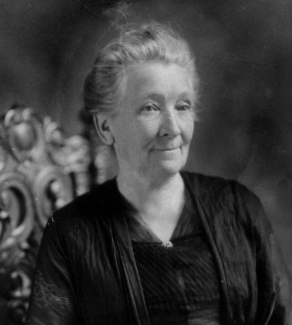Cornelia Clapp
(1849 – 1934)
First MBL Female Investigator, Librarian, and Trustee
MBL Affiliation from 1888 to 1934
When Cornelia Clapp was the very first to arrive for the MBL’s inaugural session in 1888 — one of seven investigators, four of them women—she was completing her Ph.D. from Syracuse University and was a highly regarded teacher of zoology and embryology at Mt. Holyoke College.
Wasting no time that summer, MBL Director Charles O. Whitman gave Clapp a research project on toadfish embryology, which she pursued with vigor over the next several years, publishing her observations in the Journal of Morphology in 1891.
Clapp was already an extraordinary figure. Throughout the 19th century, women had waged a protracted struggle to gain access to higher education in the United States. By the time of Clapp’s second summer in Woods Hole, only six women had been granted a Ph.D. in the sciences, and one of them was Clapp. These exceptional women had limited professional options, however; teaching at an all-women’s seminary was considered in the realm of “women’s work,” but publishing original research and joining a university faculty were not.
Encouraged by Whitman, Clapp pressed on into new scientific territory and began studying the lateral line, a system of sense organs in fish then barely described. Clapp took a leave of absence from Mt. Holyoke to complete her second Ph.D. in 1896 with Whitman at the University of Chicago; her thesis provided the first description of the lateral line system of the toadfish. Along with astronomer Maria Mitchell at Vassar, Clapp was one of the only female science professors of this first generation who published research, though it was necessarily subordinate to her teaching and administrative responsibilities.
“Her bounding vitality and search for knowledge were contagious,” according to Clapp’s contemporary, Louise Baird Wallace. “I felt I was never fully alive until I knew her.”
Clapp was considered a spell-binding teacher at Mt. Holyoke, where she largely established zoology as a laboratory science. In 1874 she had attended the Anderson School of Natural History, a summer school founded by Elizabeth and Louis Agassiz on Penikese Island, off the coast of Woods Hole. After that revelatory experience, Clapp set aside her textbooks and began teaching by hands-on investigation. To obtain specimens, she went on collecting expeditions in the United States and Europe with some of the leading naturalists of the day. And Woods Hole – where Clapp also taught in the MBL Embryology course from 1899-1903 — provided her with an abundance of marine organisms for study.
Clapp was instrumental in helping to establish the fledgling MBL. She was adamant about the need for a library in Woods Hole with subscriptions to the top scientific journals, and she served as the first MBL librarian. In that role, she initiated an exchange program whereby the MBL sent out its Biological Bulletin and received other international journals in return, which over time added up to a magnificent collection.
Clapp was elected to the MBL Board of Trustees in 1910. While three Boston women had been appointed trustees of the MBL upon its founding (Florence M. Cushing, Susan Minns, and Anna D. Phillips), women disappeared from the board after an 1897 shake-up, when the lab’s founders ceded control of the board to a national cadre of scientists. Over the next 50 years, Clapp was one of only two women (along with Ethel Brown Harvey in the 1950s) to be elected an MBL Trustee, a position she held for the rest of her life. Photographs of Clapp with the male scientists show an impressive figure, one who was much admired and valued as a fine colleague and teacher.

— By Diana Kenney
References:
Clapp, Cornelia M. (1891) “Some Points in the Development of the Toad-Fish (Batrachus Tau). J. Morphology, Vol. 5. DOI: 10.1002/jmor.1050050306
Clapp, Cornelia M. The Lateral Line System of Batrachus Tau. Boston: Ginn & Company, 1899. DOI: 10.5962/bhl.title.60392
Clapp, Pamela. “Cornelia Clapp and the Earliest Years of the MBL.” Archived at Woods Hole Historical Museum.
Maienschein, Jane. One Hundred Years Exploring Life 1888-1988: The Marine Biological Laboratory at Woods Hole. Boston: Jones & Bartlett Publishers, 1989. Digitized at: https://hdl.handle.net/1912/21938
Morgan, Ann H., Frank R. Lillie, et al. “Cornelia Maria Clapp.” Mount Holyoke Alumnae Quarterly, Vol. XIX, No. 1, May 1935.
Rossiter, Margaret W. Women Scientists in America: Struggles and Strategies to 1940. Baltimore and London, The Johns Hopkins University Press, 1982.


